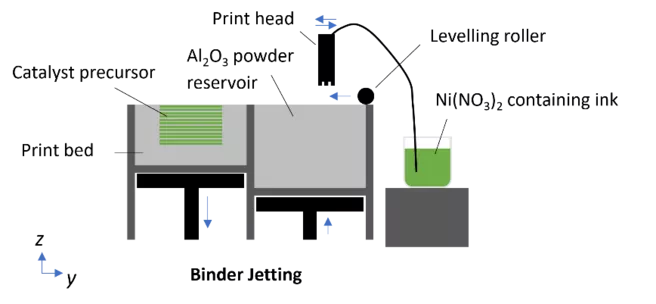The concept of power-to-methane technology presents a promising method for chemically storing surplus energy from renewable sources to match current energy demand. This is done by catalytically converting hydrogen (H2) and carbon dioxide (CO2) into methane, which can be fed directly into the existing natural gas grid.
To make CO2 methanation efficient, a catalyst is needed that is active, selective, and stable. In this context, Ni-Al catalysts are optimal candidates that are suitable for large-scale industrial use. The shape of the catalyst also significantly influences its catalytic activity. Conventional methods for shaping catalysts are often limited in terms of the complexity of the shape. Here, additive manufacturing opens up new avenues in the development of catalysts.
Previous publications by the Chair I of Technical Chemistry have already illustrated that the powder-based binder jetting process can be successfully applied to the preparation of Ni-Al catalysts with high loading, dispersion, and activity [1]. A recent publication [2] has now shown that a more advanced method, in which the active species is already included in the ink formulation, also leads to active catalysts. A further step, namely impregnation, is no longer required. This allows further development freedom and opportunities in the field of 3D printing of catalysts.
[1] Bui, Hanh My, et al. “3D Printed Co-Precipitated Ni-Al CO2 Methanation Catalysts by Binder Jetting: Fabrication, Characterization and Test in a Single Pellet String Reactor.” Applied Catalysis A: General (2022): 118760.
[2] Bui, Hanh My, et al. “In situ impregnated Ni/Al2O3 catalysts prepared by binder jet 3D printing using nickel nitrate-containing ink.” Catalysis Communications (2023): 106738.
